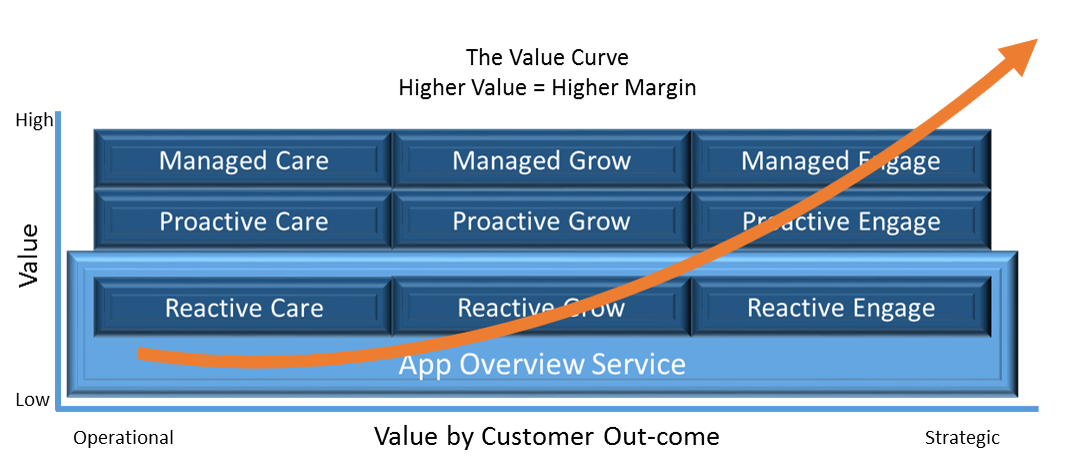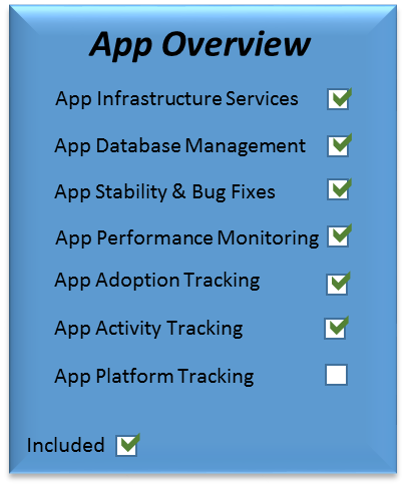In Part 1 of “Cracking the App Agency Recurring Revenue Conundrum” we talked about why it was important for every mobile app agency to build app agency recurring revenue into their business and why it makes sense to build these against the post build phases of a typical mobile app life-cycle. We also covered the 3 key things to consider when offering recurring revenue services.
We now get into the detail of exactly how to build your service offerings. We’ll cover the key questions these services should address. We’ll also show how to build a progress service offering introducing the concept of the Service Value Curve. This helps structure different levels of service so you can offer entry level services that progress up to a full managed outsource of the App. This approach lets you start slow and then progress up the Value Curve should this make sense to you and your clients.
So lets cover how you could approach defining and aligning your post build app agency recurring revenue services.
Build App Agency Recurring Revenue – Productize your Service
What works great is to “Productize” your services. Break what you offer down into chunks so your customer can easily see what they are paying for. Think of it as a menu, or a catalogue of services that you offer your clients.
Make it a service that covers the things your customer cares about most.
- Is my app working properly?
- How many people are using the app?
- How much are they using it?
- What areas of the app are they using?
- How good is the experience for them?
Build this into a simple to understand service, because simple sells.
Package these up into services that you deliver (and charge for monthly), sell them as an integrated part of your offering and NOT an after-thought and you have yourself a recurring revenue model.
The best approach is to start by sell a monthly service that’s a natural extension to the build project. App “(After)Care” where you look after the hosting and keep the app hosting infrastructure, databases and content on the app in good shape. Then build services around improving the outcome of the app for your clients – more downloads, more highly engaged app users and you have high valued offerings that your client would be happy to pay for. You also have yourself a Win/Win. Your clients win by you helping them to make their app a success. You win by get your services on retainer, and a check monthly to take the edge off your monthly fixed costs.
A Working Example – App Overview Service
It’s about turning project based revenue into ongoing services that your customers pay monthly for. Best way to do this is sell something small to start. Make it easy to sell and easy for your client to say yes to. Get them used to paying and asking you to help them fix the problems you find, (on the clock).
Here’s an example, we’ve seen work very well with one of our Mobile App Development Agencies that use Kumulos.
App Overview Service has 3 categories that together cover the 5 main areas your customers will care about most. This example is and “entry level” or “base-layer” service. It offers just a reactive services in that it will answer the questions, but stops short of suggesting any remedial action. This means you can largely automate this service and primes conversations with your clients on what you’d suggest to fix the problem (which you would do for a fee of course).
App Overview covers…
- Is the system working as it should? – Reactive Care
- Is the app user base growing? – Reactive Grow
- Are the down-loaders engaging with your app? – Reactive Engage.
It works best to make this base service reactive. A service that simply states the facts and points out the good and the bad of the important things to do with your client’s app. A “This is what we have seen” service. This will then create a dialogue with your customers, to suggest what should be fixed or done differently.
So start with a service that simply states “We’ve seen this”.
Start small then move up the Value Curve
Start by selling them the “base-layer” services. This will give an overview of the important questions. At the same time position more in-depth services, services that you offer, but they don’t need right now, but are there when their needs “mature”.
When their ready, move them up the stack to “Proactive” services.
“We’ve seen this, and this is what we have done to fix it”.
When you’re both ready, move onto Managed Services. This is an outcome based service –
“You want us to achieve this. This is what we have achieved so far and this is what we are going to do next.”
As you move from Reactive, to Proactive to Managed the Value Add increases along with the fee and of course your margin. So ultimately you want most of your clients on retained Managed App Services.
Deeper Dive – Your Service Catalog
So staying with the Reactive Overview (base-layer service). This is what you’d typically include – 7 specific service components.
In Scope
App Infrastructure Services – the app hosting, API environment and bandwidth that’s required to keep the app running.
App Database Management – to maintain the backend databases, including minor app content changes. Track data storage trends. – Pre-paid block of X hours.
App Stability & Bug Fixes – minor enhancements to keep the App running well, fix crash causes and make minor enhancements to the app – Pre-paid block of X hours.
Performance Monitoring– How well is the App running, are services responsive, is there any system latency that’s slowing down how the app is performing.
Adoption Tracking– Trends the volume of the number of times the app is downloaded, looking at short, mid and longer term trends, is adoption growing or slowing.
Activity Tracking– Trends how the app is getting used. Once the app is downloaded is it getting used and is usage growing or slowing. Have any recent changes or new feature enhancements changed how the apps being used? What are the most used and least used areas of the app.
App Platform Tracking – Shows the which platform versions of the app have been downloaded, the current mix of platforms and whether over time which platforms are most popular.
Out of Scope
Arguably more important than defining what’s in scope for your service, is explicitly defining what’s out of scope. This helps you set expectations up front and make sure your clients (and the team delivering the service for your agency) know what’s included and what’s extra. It also makes it easier to define when your client is ready to move up to the next “proactive” service.
The things that are typically out of scope include
Content Management Services – ie regular and frequent update of content. Spelling mistakes are OK or the occasional change.
App Development – including new features, existing feature/function enhancements (that aren’t bug fixes) and platform version upgrades.
The advantage of this approach is it gives your customer transparency around what is priced into your service. It also means you can structure the service as a menu, some are mandatory (like App Infrastructure Services – i.e. App hosting), others will depend on the type of app you’ve built. For example, if it’s just built in iOS, the App Platform Tracking service block isn’t going to be any use.
Summing up Part 2
In Part 1 we covered why its important to consider the full App Life Cycle as part of your App Agency offering. This means you are not limiting your income to just the few months of the mobile app build, but across the multi-year life of the app. We also explored the 3 main things you need to consider when getting ready to build recurring revenue offerings – Skill-sets, Making it a core part of what you do and Start slow.
Here we covered how you could productise your post build service offerings making sure that they cover the 5 key questions your customers will have about their app. We’ve suggested an example of how you can make this work by offering an entry level or base-layer service and structuring your service offerings so its easy to move your customers up the value curve when you and they are ready.
In Part 3 we round this off with how to present and deliver App Agency Recurring Revenue services. We’ll cover the importance of the monthly report and regular review meetings to make sure you drive home your value. We will also cover the mos tricky part of this – how to price.






